As robotaxi companies in the USA prepare to launch their autonomous vehicles in more cities, safety is in the spotlight again. And quite rightly. Many autonomous mobility service companies have relied on two factors when developing their vehicles: active safety...










